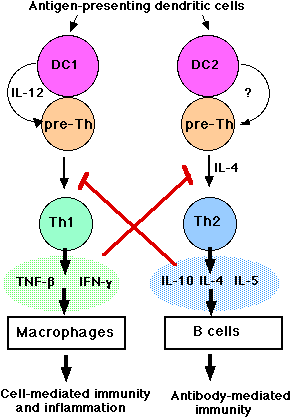T Helper Cells
T helper cells (also called helper T cells) are
Types of Helper T Cells
There are two distinct kinds:
- Th1
- Th2
- These provide help for B cells and, in so doing, are essential for antibody-mediated immunity. Antibodies are needed to control extracellular pathogens (which - unlike intracellular parasites - are exposed to antibodies in blood and other body fluids).
Origin of Helper T Cells
Like all T cells, Th cells arise in the thymus.
- When they acquire CD4, they are called pre-Th cells.
- When they are presented with an antigen, they begin to proliferate and become activated.
- It is the nature of the antigenic stimulation that appears to determine which path they enter: the path leading to Th1 cells or the path leading to Th2 cells.
The antigen-presenting cells (APCs) are called dendritic cells (DC). They
- ingest antigen by phagocytosis or pinocytosis
- degrade it
- present fragments of the antigen in MHC molecules on their surface
There are two kinds of dendritic cell:
- DC1 - these are descended from monocytes
- DC2 - these appear to be derived from lymphocytes
Th1 Cells
 Th1 cells are produced when
Th1 cells are produced when
- DC1-type dendritic cells present antigen to the T cell's receptor for antigen (TCR)
- secrete interleukin 12 (IL-12)
- this paracrine stimulation activates the Th1 cells to secrete their own lymphokines.
The major lymphokines secreted by Th1 cells are
- Tumor-necrosis factor-beta (TNF-beta) (also known as lymphotoxin) and
- Interferon-gamma (IFN-gamma)
These
- stimulate macrophages to kill the bacteria they have engulfed by phagocytosis
- recruit other leukocytes to the site producing inflammation.
Th2 Cells
Th2 cells are produced when DC2-type dendritic cells present antigen to the T cell's receptor for antigen (TCR) and, presumably, one or more paracrine stimulants. The identity of the lymphokine(s) is still uncertain (indicated by a ? in the figure).
The major lymphokines secreted by Th2 cells are
- interleukin 4 (IL-4). This stimulates class-switching in B cells and promotes their synthesis of IgE antibodies. It also acts as a positive-feedback device promoting more pre-Th cells to enter the Th2 pathway.
- Interleukin 13 (IL-13). This also promotes the synthesis of IgE antibodies.
- Interleukin 5 (IL-5). Attracts and activates eosinophils.
- Interleukin 10 (IL-10). Inhibits pre-Th cells from entering the Th1 pathway (shown in red).
Reciprocal inhibition of Th1 and Th2 cells.
The antigenic stimulus that sends pre-Th cells down one path or the other also sets the stage for reinforcing the response.
A Th1 response inhibits the Th2 path in two ways:
- IFN-gamma (shown above in red) and IL-12 inhibit the formation of Th2 cells
- IFN-gamma also inhibits class-switching in B cells.
A Th2 response inhibits the Th1 path:
- IL-10 suppresses Th1 formation (shown above in red)
Negative feedback of Th1 and Th2 cell formation
There is also evidence that late in the immune response, negative feedback mechanisms come into play to dampen the response.
- IL-4 kills the precursors of the DC2 cells (by apoptosis) thus inhibiting the Th2 path and further production of IL-4
- Interferon-gamma may eventually turn off the Th1 response that produced it.
Th1 and Th2 cells have different chemokine receptors.
Chemokines are cytokines that are chemotactic for (attract) leukocytes. Because they are chemotactic cytokines, chemokines are designated by the initials CC.
Chemokines bind to receptors on the responding leukocyte. The receptors are transmembrane proteins with the chemokine binding site exposed at the surface of the plasma membrane. Chemokine receptors are designated CCR.
With their different functions, we might expect that Th1 cells and Th2 cells would respond differently to chemokines. And so they do.
- Th1 cells express the chemokine receptor CCR5 (but not CCR3).
- Th2 cells express the chemokine receptor CCR3 (but not CCR5).
CCR3
The chemokine that binds to CCR3 is called eotaxin.
It is secreted by epithelial cells and phagocytic cells in regions where allergic reactions are occurring.
CCR3 is found on
all cells implicated in allergic responses (e.g., asthma).
CCR5
CCR5 is found on
CCR5 also acts - along with the CD4 molecule - as a receptor for HIV-1, the retrovirus that causes AIDS. This fact may explain
- why certain HIV-infected men with inherited mutations in CCR5 can tolerate their infection for long periods without progressing to a full-blown case of AIDS.
- The collapse of cell-mediated immunity in the late stages of AIDS.
24 June 1999
 Th1 cells are produced when
Th1 cells are produced when